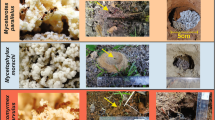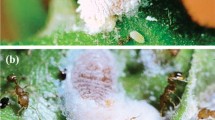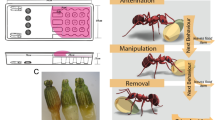Abstract
Ants belong to the most important groups of arthropods, inhabiting and commonly dominating most terrestrial habitats, especially tropical rainforests. Their highly collective behavior enables exploitation of various resources and is viewed as a key factor for their evolutionary success. Accordingly, a great variety of life strategies evolved in this group of arthropods, including seed harvesters, gardeners, and planters, fungus growers, nomadic hunters, life stock keepers, and slave makers. This study reports the discovery of a new lifestyle in ants. In a Southeast Asian rainforest habitat, Euprenolepis procera is specialized in harvesting a broad spectrum of naturally growing mushrooms, a nutritionally challenging and spatiotemporally unpredictable food source. While unfavorable to the vast majority of animals, E. procera has developed exceptional adaptations such as a shift to a fully nomadic lifestyle and special food processing capabilities, which allow it to rely entirely on mushrooms. As a consequence, E. procera is the most efficient and predominant consumer of epigeic mushrooms in the studied habitat and this has broad implications for the tropical rainforest ecosystem.


Similar content being viewed by others
References
Aanen DK, Eggleton P, Rouland-Lefèvre C, Guldberg-Frøslev T, Rosendahl S, Boomsma JJ (2002) The evolution of fungus-growing termites and their mutualistic fungal symbionts. Proc Natl Acad Sci U S A 99:14887–14892
Davidson DW (1998) Resource discovery versus resource domination in ants: a functional mechanism for breaking the trade-off. Ecol Entomol 23:484–490
Dell B (2002) Role of mycorrhizal fungi in ecosystems. CMU J Nat Sci 1:47–60
Dix NJ, Webster J (1995) Fungal ecology. Chapman & Hall, London
Farrell BD, Seqeira AS, O’Meara BC, Normark BB, Chung JH, Jordal BH (2001) The evolution of agriculture in beetles (Curculionidae: Scolotinae and Platypodinae). Evolution 55:2011–2027
Gotwald WH (1995) Army ants—the biology of social predation. Cornell University Press, Ithaca
Hammond PM, Lawrence JF (1989) Mycophagy in insects: a summary. In: Webber JF (ed) Insect-fungus interactions. Academic Press, London, pp 275–324
Hölldobler B, Wilson EO (1990) The ants. The Belknap Press of Harvard University Press, Cambridge, MA
Jacobs W, Renner M (1998) Biologie und Ökologie der Insekten: ein Taschenlexikon. Fischer, Stuttgart
Johnson CN (1994) Nutritional ecology of a mycophagous marsupial in relation to production of hypogeous fungi. Ecology 75:2015–2021
MacMahon JA, Mull JF, Crist TO (2000) Harvester ants (Pogonomyrmex spp.): their community and ecosystem influences. Ann Rev Ecol Syst 31:265–291
Martin MM (1979) Biochemical implications of insect mycophagy. Biol Rev Camb Philos Soc 54:1–21
Martin MM (1992) The evolution of insect-fungus associations: from contact to stable symbiosis. Am Zool 32:593–605
Maschwitz U, Hänel H (1985) The migrating herdsman Dolichoderus (Diabolus) cuspidatus: an ant with a novel mode of life. Behav Ecol Sociobiol 17:171–184
Maschwitz U, Steghaus-Kovac S, Gaube R, Hänel H (1989) A South East Asian ponerine ant of the genus Leptogenys (Hym., Form.) with army ant life habits. Behav Ecol Sociobiol 24:305–316
Mueller UG, Gerardo N (2002) Fungus-farming insects: multiple origins and diverse evolutionary histories. Proc Natl Acad Sci U S A 99:15247–15249
Mueller UG, Rehner SA, Schultz TR (1998) The evolution of agriculture in ants. Science 281:2034–2038
Mueller UG, Gerardo NM, Aanen DK, Six DL, Schultz TR (2005) The evolution of agriculture in insects. Annu Rev Ecol Evol System 36:563–595
Newman EI, Reddell P (1987) The distribution of mycorrhizas among families of vascular plants. New Phytol 106:745–751
North M, Trappe J, Franklyn J (1997) Standing crop and animal consumption of fungal sporocarps in pacific northwest forests. Ecology 78:1543–1554
Reddel P, Spain AV, Hopkins M (1997) Dispersal of spores of mycorrhizal fungi in scats of native mammals in tropical forests of Northeastern Australia. Biotropica 29:184–192
Rissing SW (1986) Indirect effects of granivory by harvester ants: plant species composition and reproductive increase near ant nests. Oecologia 68:231–234
Schultz TR, Brady SG (2008) Major evolutionary transitions in ant agriculture. Proc Natl Acad Sci U S A 105:5435–5440
van der Heijden MGA, Klironomos JN, Ursic M, Moutoglis P, Streitwolf-Engel R, Boller T, Wiemken A, Sanders IR (1998) Mycorrhizal fungal diversity determines plant biodiversity, ecosystem variability and productivity. Nature 396:69–72
Wang B, Qiu Y-L (2006) Phylogenetic distribution and evolution of mycorrhizas in land plants. Mycorrhiza 16:299–363
Ward PS (2006) Ants. Curr Biol 16:152–155
Acknowledgements
We are grateful for financial support from the DFG (Deutsche Forschungsgemeinschaft). Thanks to J. S. LaPolla for species determination and to J. Meinwald, L. Abrell, S. Foitzik, and R. Morrison for helpful comments on the manuscript.
Author information
Authors and Affiliations
Corresponding author
Additional information
Communicated by: J. Heinze
Rights and permissions
About this article
Cite this article
Witte, V., Maschwitz, U. Mushroom harvesting ants in the tropical rain forest. Naturwissenschaften 95, 1049–1054 (2008). https://doi.org/10.1007/s00114-008-0421-9
Received:
Revised:
Accepted:
Published:
Issue Date:
DOI: https://doi.org/10.1007/s00114-008-0421-9




